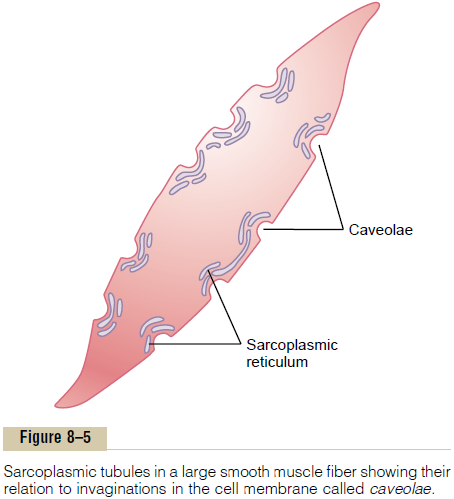Chapter: Medical Physiology: Contraction and Excitation of Smooth Muscle
Source of Calcium Ions That Cause Contraction (1) Through the Cell Membrane and (2) from the Sarcoplasmic Reticulum
Source of Calcium Ions That Cause Contraction (1) Through the Cell Membrane and (2) from the Sarcoplasmic Reticulum
Although the contractile process in smooth muscle, as in skeletal muscle, is activated by calcium ions, the source of the calcium ions differs; the difference is that the sarcoplasmic reticulum, which provides virtually all the calcium ions for skeletal muscle con-traction, is only slightly developed in most smooth muscle. Instead, almost all the calcium ions that cause contraction enter the muscle cell from the extra-cellular fluid at the time of the action potential or other stimulus. That is, the concentration of calcium ions in the extracellular fluid is greater than 10-3 molar, in comparison with less than 10-7 molar inside the smooth muscle cell; this causes rapid diffusion of the calcium ions into the cell from the extracellular fluid when the calcium pores open. The time required for this diffusion to occur averages 200 to 300 mil-liseconds and is called the latent period before con-traction begins. This latent period is about 50 times as great for smooth muscle as for skeletal muscle contraction.
Role of the Smooth Muscle Sarcoplasmic Reticulum. Figure8–5 shows a few slightly developed sarcoplasmic tubules that lie near the cell membrane in some larger smooth muscle cells. Small invaginations of the cell membrane, called caveolae, abut the surfaces of these tubules. The caveolae suggest a rudimentary analog of the transverse tubule system of skeletal muscle. When an action potential is transmitted into the caveolae, this is believed to excite calcium ion release from the abutting sarcoplasmic tubules in the same way that action potentials in skeletal muscle transverse tubules cause release of calcium ions from the skeletal muscle longitudinal sarcoplasmic tubules. In general, the more extensive the sarcoplasmic re-ticulum in the smooth muscle fiber, the more rapidly it contracts.

Effect on Smooth Muscle Contraction Caused by Changing of Extracellular Calcium Ion Concentration. Although chang-ing the extracellular fluid calcium ion concentration from normal has little effect on the force of contrac-tion of skeletal muscle, this is not true for most smooth muscle. When the extracellular fluid calcium ion con-centration falls to about 1/3 to 1/10 normal, smooth muscle contraction usually ceases. Therefore, the force of contraction of smooth muscle usually is highly dependent on extracellular fluid calcium ion concentration.
A Calcium Pump Is Required to Cause Smooth Muscle Relaxation. To cause relaxation of smooth muscle afterit has contracted, the calcium ions must be removed from the intracellular fluids. This removal is achieved by a calcium pump that pumps calcium ions out of the smooth muscle fiber back into the extra-cellular fluid, or into a sarcoplasmic reticulum, if it is present.
This pump is slow-acting in comparison with the fast-acting sarcoplasmic reticulum pump in skeletal muscle. Therefore, a single smooth muscle contraction often lasts for seconds rather than hun-dredths to tenths of a second, as occurs for skeletal muscle.
Related Topics